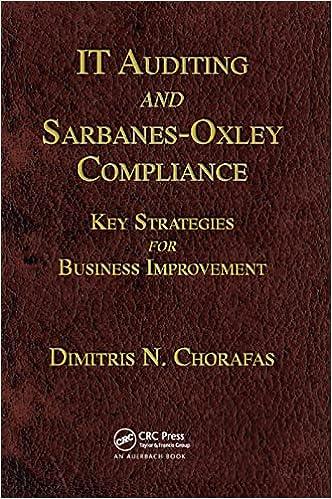Answered step by step
Verified Expert Solution
Question
1 Approved Answer
Please show work with the answer. Show the Excel formulas, please. Thank you! Please use Du Pont to solve inventory turnover. Use the following information
Please show work with the answer. Show the Excel formulas, please. Thank you!
Please use Du Pont to solve inventory turnover.



Use the following information to answer the questions below: note: all sales are credit sales 2019 2020 Income Stmt info: Sales $ less Cost of Goods Sold: Gross Profit Operating Expenses Earnings before Interest & Taxes Interest exp earnings before Taxes Taxes Net Income $ 800,000 $ 220,000 580,000 480,000 100,000 25,000 75,000 25,000 50,000 $ 880,000 240,000 640,000 505,000 135,000 25,000 110,000 30,000 80,000 Balance Sheet info: Cash Accounts Receivable Inventory Total Current Assets Fixed Assets (Net) Total Assets 12/31/2019 12/31/2020 60,000 $ 65,000 90,000 $ 95,000 110,000 $ 130,000 260,000 $ 290,000 300,000 $ 330,000 560,000 $ 620,000 $ $ $ Current Liabilities Long Term Liabilities Total Liabilities $ $ $ $ 130,000 $ 170,000 $ 300,000 $ 260,000 $ 560,000 $ 140,000 200,000 340,000 280,000 620,000 Stockholder's Equity Total Liab & Equity: $ Compute each of the following ratios for 2019 and 2020 and indicate whether each ratio was getting "better" or "worse" from 2019 to 2020 and whether the 2020 ratio was "good" or "bad" compared to the Industry Avg (round all numbers to 2 digits past the decimal place) "Good" or "Bad" Getting compared Better or 2020 to Getting Industry Industry 2019 2020 Worse? Avg Avg Profit Margin 0.08 Current Ratio 1.80 Quick Ratio 1.12 Return on Assets 0.18 Debt to Assets 0.60 Receivables turnover 12.00 Avg. collection period* 22.10 Inventory Turnover** 8.25 Return on Equity 0.16 Times Interest Earned 8.15 * Assume a 360 day year **Inventory Turnover can be computed 2 different ways. Use the formula listed in the text (the one the text indicates many credit reporting agencies generally use) Du Pont system of analysis An analysis of profitability that breaks down return on assets between the profit margin and asset turnover. The second, or modified version shows how return on assets is translated into return on equity through the amount of debt that the firm has Actually, return on assets is divided by (1 2 Debt/Assets) to arrive at return on equity
Step by Step Solution
There are 3 Steps involved in it
Step: 1

Get Instant Access to Expert-Tailored Solutions
See step-by-step solutions with expert insights and AI powered tools for academic success
Step: 2

Step: 3

Ace Your Homework with AI
Get the answers you need in no time with our AI-driven, step-by-step assistance
Get Started


